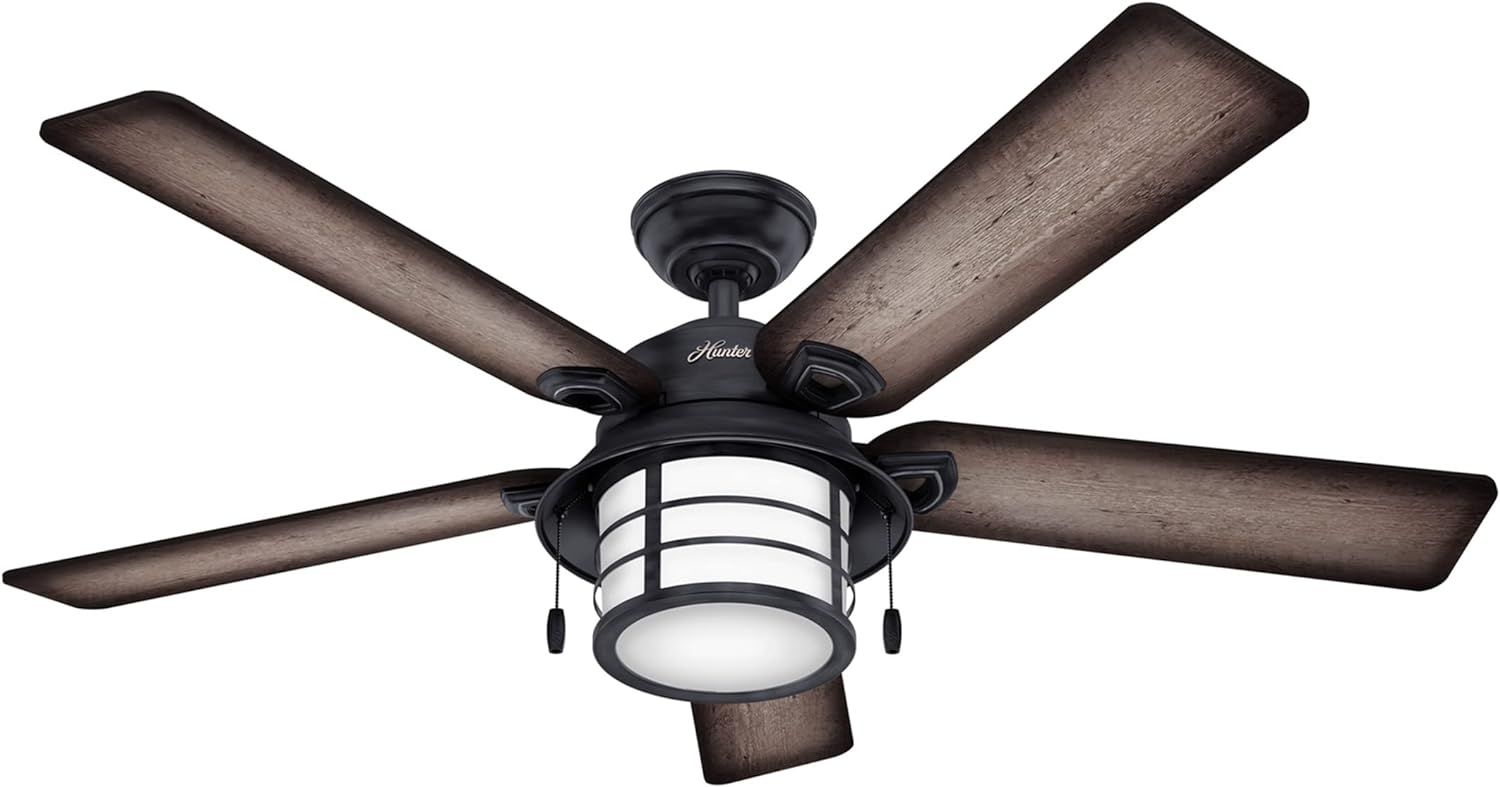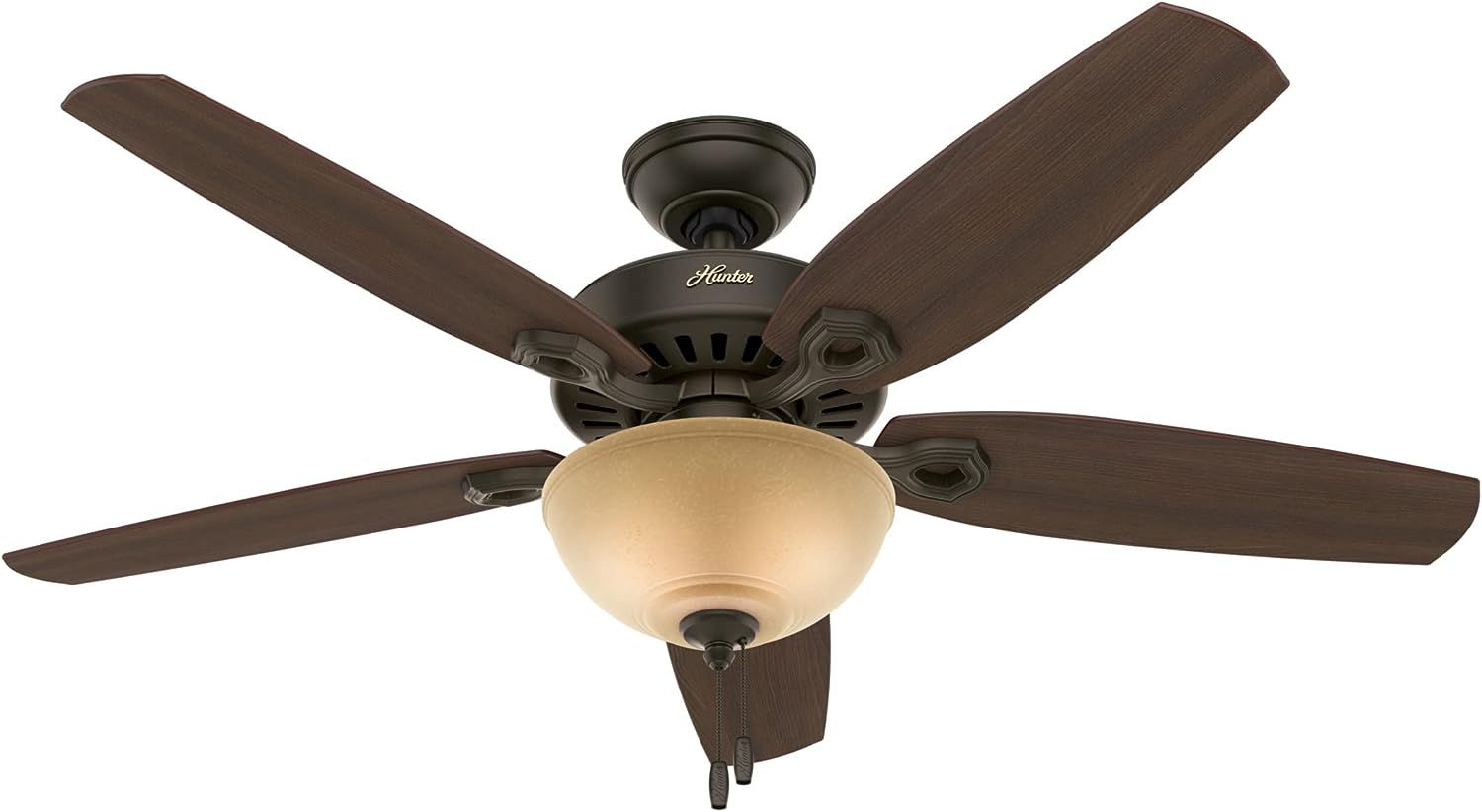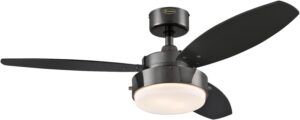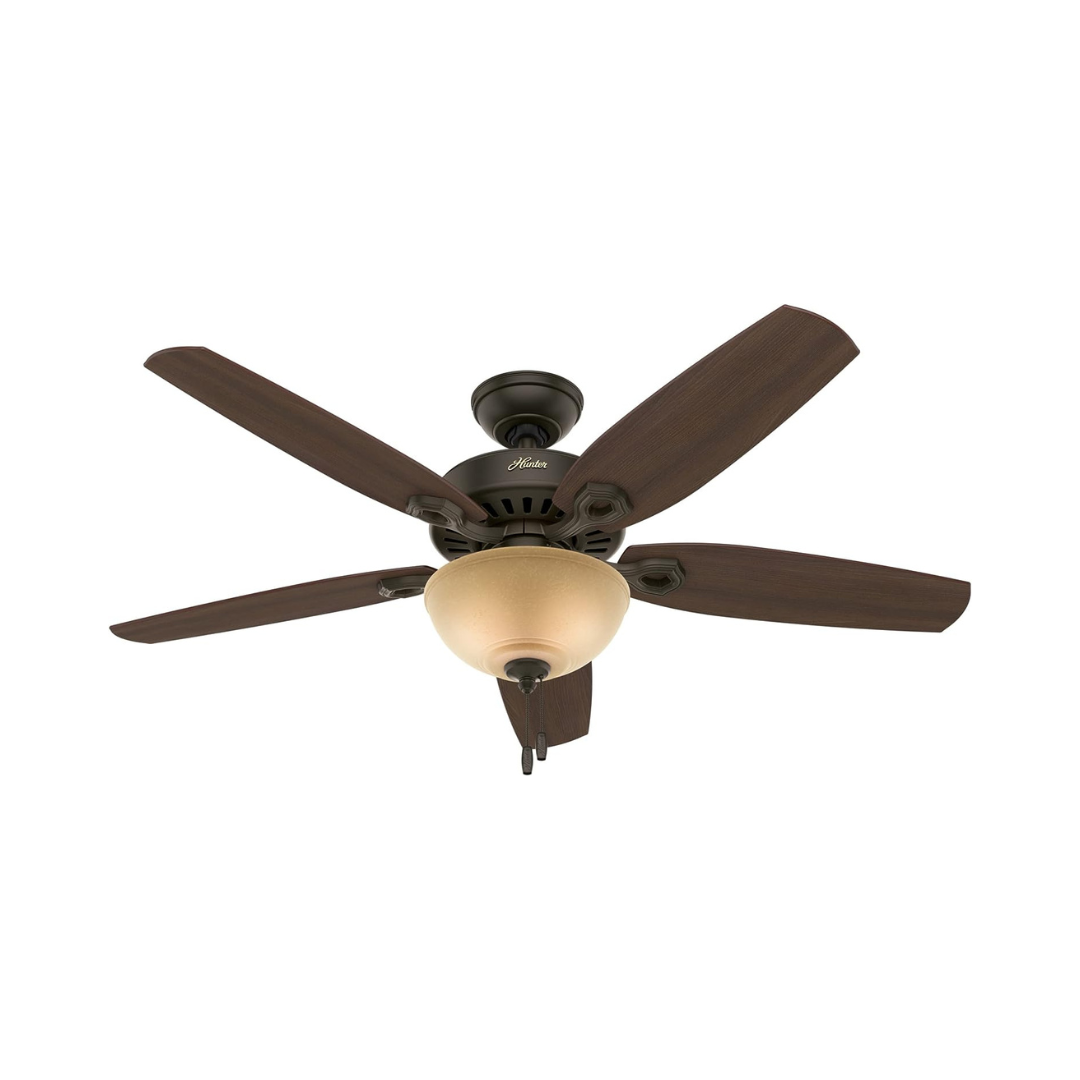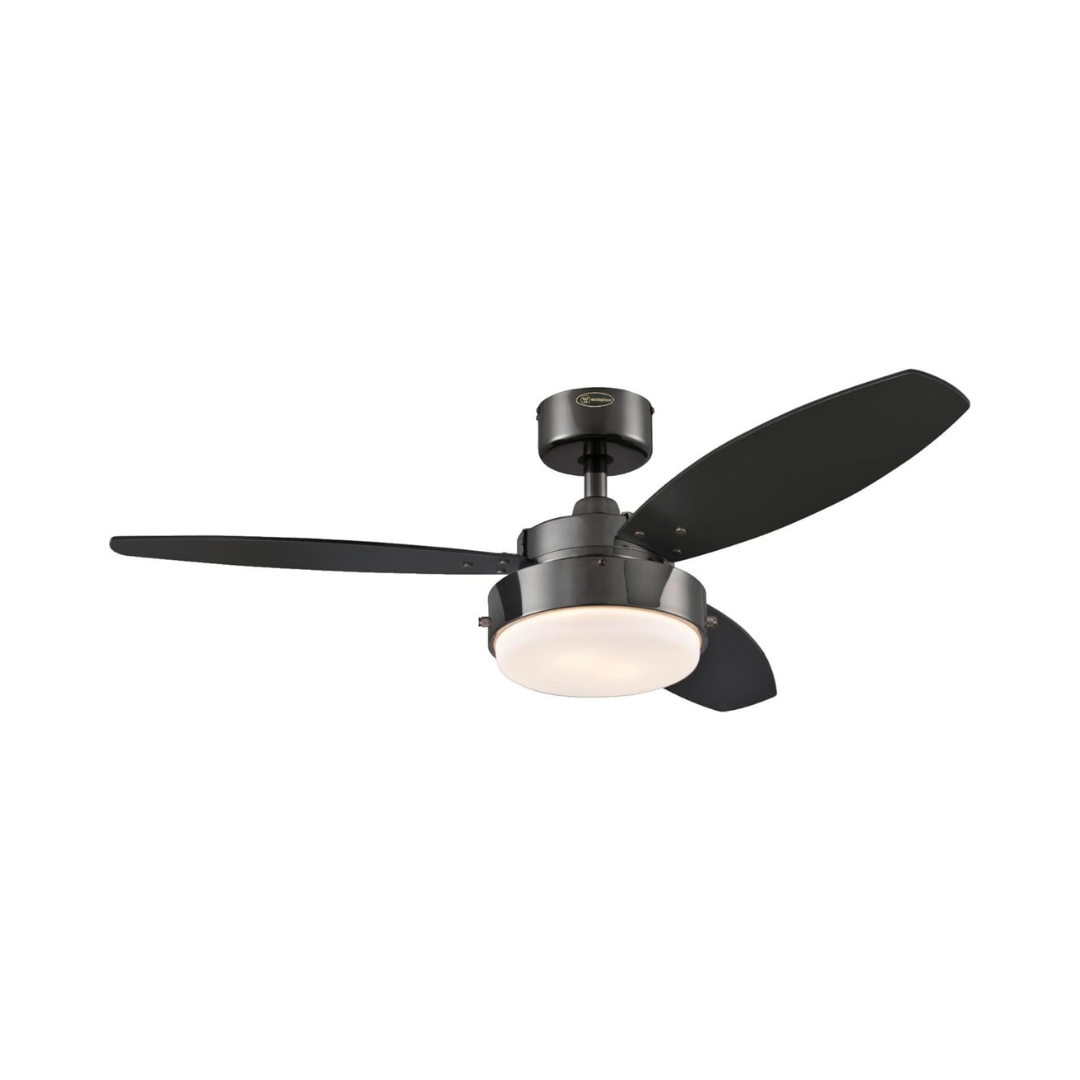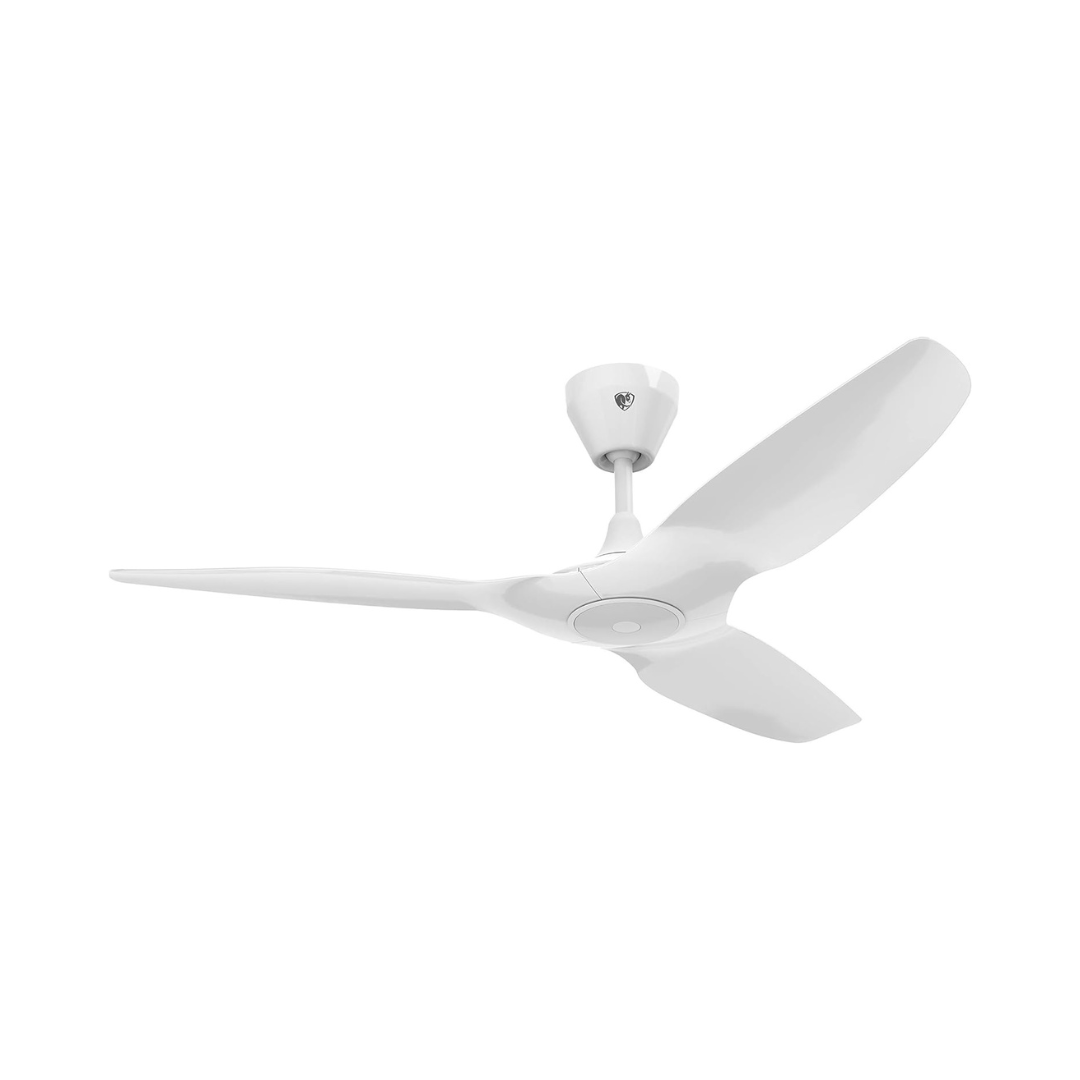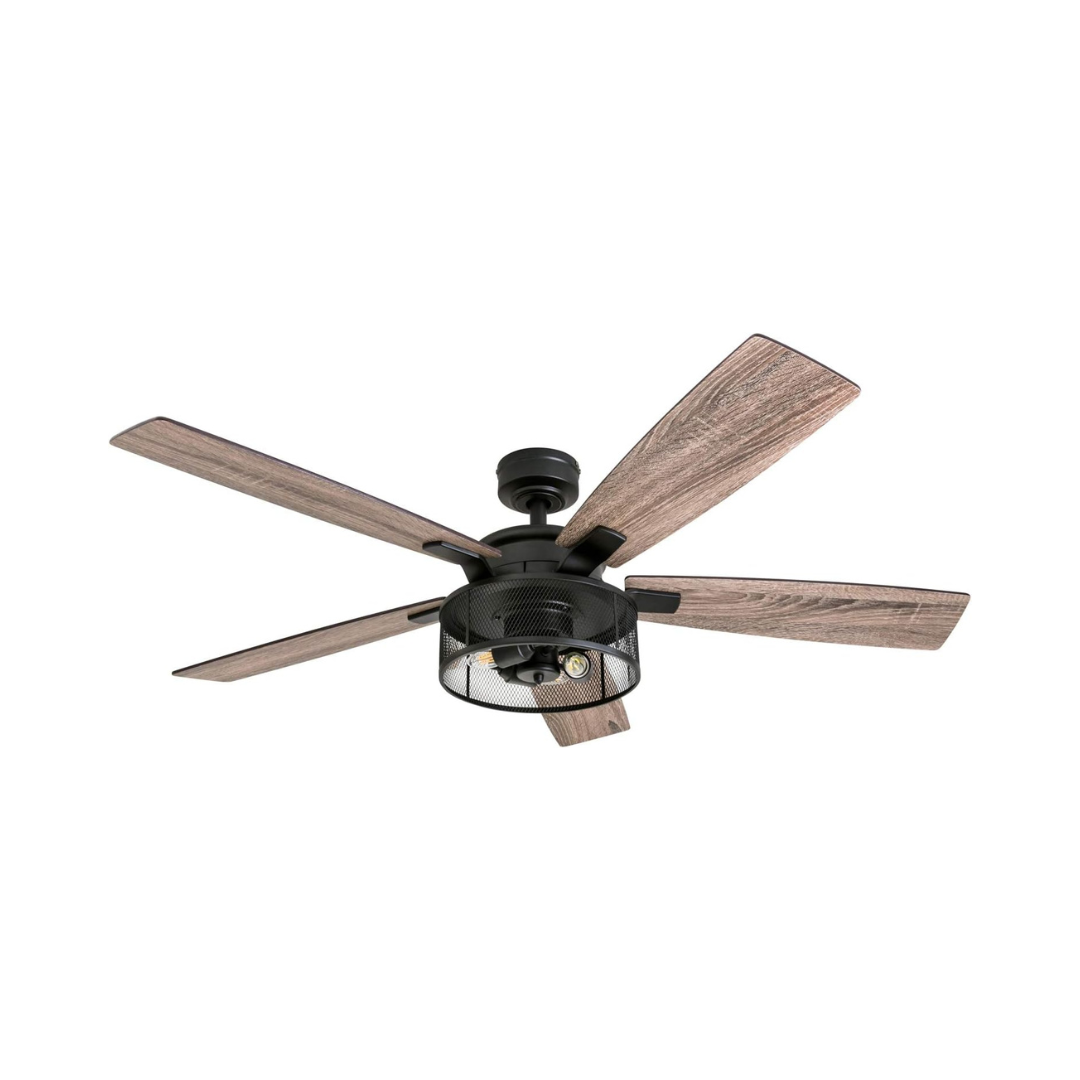We may be compensated if you purchase through links on our website. Our team is committed to delivering honest, objective, and independent reviews on home products and services.
Whether you want to circulate fresh, cool air throughout your home or complement existing room décor, a ceiling fan can be an excellent purchase. But with so many different models, sizes, and features to consider, finding the right ceiling fan for your bedroom or den can be a challenge.
To help you narrow down your choices, we looked at over 50 of the top ceiling fans on the market and read over 300 customer reviews. Overall, our choice for the best overall ceiling fan is the Hunter Key Biscayne Weathered Zinc, which has a traditional, classic design that fits with any decor type and delivers excellent airflow for small or medium-sized rooms.
Our research showed that ceiling fans can vary greatly in price, with most models costing around $100-$250 depending on the airflow and size, but some more premium, larger models costing significantly more, sometimes upwards of $600 or $700. Read our guide below for more of our top picks.
Best Overall
Good For: Customers looking for a high-quality, affordable fan with excellent airflow for bedrooms or living rooms.
What Are People Saying About the Hunter Key Biscayne Weathered Zinc?
We found that customers who were impressed with this fan liked that it had an excellent airflow and was easy to install. Others were pleased with its stylish, modern design. However, there were several complaints that this fan was overly noisy, while others were let down by the lack of remote control.
“We got two of these fans, and we absolutely love them! They look great, installation wasn’t bad, and the light produced is plenty….The best part is that it really pushes the air and with these installed on our patio in Phoenix… well, air movement is very important. Very happy with these fans!” — Heidi McBreen via Amazon
“…Once installed, it made a horrid rubbing noise. We were able to lower the shroud using washers to eliminate the rubbing. The speeds are not typical for ceiling fan speeds. The slow and medium speeds are pretty much pointless to use. The high speed is high.” — J. Weinzerl via Amazon
Best Value
Good For: Homeowners seeking a traditionally-designed fan that is well-constructed and has a reversible fan motor.
What Are People Saying About the Hunter Builder Deluxe 5-Blade?
Customers who left positive feedback for this fan liked that it was quiet and moved air well. Others were pleased with its excellent value. On the other hand, some who gave this product negative reviews said that it broke easily, while others found the lighting unit to be inadequate.
“I’m so pleased with this fan I’m purchasing number five of the same item right now. Excellent build quality. Excellent finish. Very heavy and very solid construction. … Perfect balance at every speed right out of the box. It’s nice they included a mini blade balancing kit and even nicer that I have not had to use a single one of them! … Absolutely dead quiet! Not a trace of electrical/motor hum or AC buzzing,” — John PT via Amazon
“The fan itself is great. The light is awful, and I wish I did not have the fan, but too late. If you have a room where you need a lot of light, then do not get this fan. If you only need moderate to low light, then you will be very happy with this fan. The problem is that it uses two candelabra 60-watt light bulbs. … I did not realize this had candelabra bulbs, and there is no room to add an adapter and then larger bulbs..” —TJ via Amazon
Best for Small Spaces
Good For: Homeowners in the market for a sleek, attractive fan that wits well with modern decor.
What Are People Saying About the Westinghouse Gun Metal Fan?
Our team found that customers who were satisfied with this fan generally liked its high airflow output, straightforward design, and high-quality light. However, there were some who found this fan to be challenging to install, and others said it often made loud noises.
“This fan is amazing! The price is unbelievable. It has a gorgeous compact appearance and an elegant black metallic finish. My husband actually had an enthusiastic ‘Wow!’ reaction to the appearance and then an emphatic ‘WOW’ at the price. It is small but produces perfect airflow. Even the “low” setting was moving air well” — Nebula via Amazon
“If you are looking for a silent or quiet fan, look elsewhere. If you are fine with the noise from it, then this is a good cheap fan to buy. We installed it in our bedroom, and luckily for us, it’s like a sound machine, and we sleep through the noise. It is a smaller sized fan, great for small rooms. We could have gone bigger for the size of our bedroom, but there is no need – this does the job of cooling off the room and creating great airflow.” — Walter Ostile via Amazon
Best Smart Fan
Good For: Customers seeking a high-end end with smart control and enough airflow to cool a large room.
What Are People Saying About the Big Ass Fans Haiku Smart Ceiling Fan?
Those who were pleased with this ceiling fan were wowed by its plethora of unique features and speed settings, with many customers raving about the airflow and smartphone compatibility. Others liked the design and high-quality build. However, those who had more mixed opinions felt this fan was difficult to install, and others noted it frequently squeaked or made other noises.
“I’ve always wanted a Big Ass fan and am not disappointed. The installation was very easy. Blades come color-matched and balanced, so there is literally no wobble. The fan is 100% silent. … The light is bright, and the breeze is awesome. I really like the app, and it works flawlessly with my iPhone. … There’s even an option for a natural breeze at night so that the air speed increases and decreases to be more natural (it’s slight, so low speed is still low speed). You can even set a timer. — Tattooos via Amazon
“While the installation appears to be simple, putting the wires into the necessary places and then adding two covers (one facing downwards and the other facing upwards) is a real pain. You have to really navigate the cables almost perfectly in order to have a snug fit. The top cover (one facing upwards) requires pulling up with a lot of force and rotating to lock it in place. Pulling up is one nightmare, but the rotation is the most difficult experience. I can’t understand why don’t the manufacturer leave some additional room for the cables or put threads to rotate it easily.” — S Vani via Amazon
Best Rustic Design
Good For: Homeowners with rustic decor looking for a well-built fan that can cool smaller bedrooms or dining rooms.
What Are People Saying About the Honeywell Carnegie Ceiling Fan?
Reviewers who liked this ceiling fan were impressed with its high-quality construction and durable materials. Others commented on its stylish design. However, others said it was loud, and some customers claimed that getting the remote control receiver was a headache.
“So glad I decided on this fan for our living room. It was easy to install (took about 30-45 min, including taking down the old fan) and is super quiet. We didn’t even need to use the balancing weights. I really think you will be happy with the quality of this fan.— Dale G. via Amazon
“The fan it’s self is very nice and fairly easy to put up in comparison to other ceiling fans. The problem comes with the remote. It has a transponder box that is to be wired with the fan motor, and there simply is not room for it to go in with the other wires. I would suggest a fan with the remote transponder was built into the housing of the fan itself. The fan does not have pull switches, so if you decide that there is no room for the transponder, you won’t be able to control the light or fan. However, it is nice looking” —Tasha via Amazon
Types of Ceiling Fans
Each type of ceiling fan is designed for specific environments and needs. Understanding these different types will help you choose the right fan for your space.
Indoor Ceiling Fans
Indoor ceiling fans are a common type designed for use in enclosed spaces. They come in various sizes, styles, and finishes to suit different room sizes and decor preferences.
- Dual-motor fans: These fans have two motors and can move a large volume of air, making them suitable for large spaces.
- Low-profile or hugger fans: Ideal for rooms with low ceilings, these fans mount flush against the ceiling.
- Standard ceiling fans: These versatile fans can fit in most rooms with standard ceiling heights.
Outdoor Ceiling Fans
Outdoor ceiling fans are specifically designed to withstand exposure to the elements. They are perfect for patios, porches, and other covered outdoor areas. Key features of outdoor fans include:
- Damp-rated fans: Suitable for covered outdoor areas protected from direct water exposure.
- Marine-grade fans: Designed to resist salt air corrosion, these are perfect for coastal areas.
- Wet-rated fans: These can withstand direct exposure to rain and snow, making them ideal for uncovered outdoor spaces.
Smart Ceiling Fans
Smart ceiling fans are the latest innovation in fan technology. These fans can be controlled via smartphone apps or voice commands through smart home systems. Features of smart fans may include:
- Remote operation: Control your fan from anywhere using your smartphone.
- Scheduling: Set your fan to turn on or off at specific times.
- Integration with other smart home devices: Coordinate your fan’s operation with your thermostat or lighting for maximum energy efficiency.
How To Choose the Right Ceiling Fan Size
Selecting the correct size ceiling fan matters for performance and aesthetics. A fan that’s too small won’t move enough air, while one that’s too large can overwhelm the space.
Room Size Considerations
When choosing a ceiling fan, consider both the square footage and the ceiling height of your room. Here are some general guidelines:
- For rooms up to 75 square feet: Choose a fan with a 29- to 36-inch blade span.
- For rooms 76 to 144 square feet: Opt for a 36- to 42-inch blade span.
- For rooms 145 to 225 square feet: Select a 44- to 50-inch blade span.
- For rooms 225 to 400 square feet: Go for a 50- to 54-inch blade span.
For rooms larger than 400 square feet, consider installing multiple fans or a fan with a blade span of 60 inches or more.
Fan Blade Span Guidelines
The blade span, or sweep, is the diameter of the circle created by the rotating blades. Here’s how to size up a ceiling fan based on room dimensions:
- Up to 50-square-foot room: 30-inch span
- 51 to 100-square-foot room: 36-inch span
- 101 to 200-square-foot room: 42-inch span
- 201 to 400-square-foot room: 52-inch span
- More than 400-square-foot room: 54-inch span or larger
Remember, in long, narrow spaces or very large rooms, you can install multiple fans for better air circulation.
Key Features To Look for in a Ceiling Fan
When shopping for a ceiling fan, several key features can impact its performance, durability, and overall value. Here’s what to consider:
Fan’s Motor Quality and Power
The motor is the heart of any ceiling fan. Look for fans with high-quality motors that offer:
- Quiet operation: Look for motors with sealed bearings that never need oiling.
- Reversible function: This allows the fan to be used year-round for both cooling and heating efficiency.
- Sufficient power: Motors range from 1/60 to 1/3 horsepower. Higher-power motors can handle larger blade spans and steeper pitches.
Fan’s Blade Design and Materials
A fan’s blades impact its performance and appearance:
- Blade pitch: Look for angles between 11 and 16 degrees for ideal air movement.
- Material: Wood blades should be sealed to prevent warpage. Plastic blades are often used in damp locations.
- Number of blades: While more blades can make a fan quieter, they don’t necessarily move more air.
Lighting Options
Many ceiling fans come with built-in light fixtures, offering versatile lighting options:
- Downlights: These provide focused light directly below the fan.
- LED options: Energy-efficient LED lights are becoming increasingly common in ceiling fans.
- Uplights: These bounce light off the ceiling for softer, ambient illumination.
Control Mechanisms on Fans
Today’s ceiling fans offer a range of control options for your convenience:
- Pull chains: Traditional pull chains allow you to control the fan and light separately.
- Remote controls: Many modern fans include handheld remote controls, offering greater flexibility.
- Wall controls: Some fans come with wall-mounted controls, providing an alternative to pull chains or remotes.
Top Ceiling Fan Brands and Their Offerings
Several brands stand out in the ceiling fan market for their quality, innovation, and design. Understanding what each brand offers can help you make an informed choice for your home.
Casablanca
Casablanca is known for its high-end, stylish fans with powerful motors. Key features include:
- Proprietary Direct Drive motor technology for quiet operation
- Smart home integration options
- Wide range of finishes and styles
Hunter
Hunter has been a leader in the ceiling fan industry for over 130 years. They offer:
- Affordable options without compromising on quality
- A variety of styles, from traditional to modern
- Exclusive WhisperWind motor for quiet performance
Minka-Aire
Minka-Aire is recognized for its contemporary and unique designs. Their fans feature:
- Energy-efficient DC motors in many models
- Integrated LED lighting options
- Sleek, modern aesthetics
Hampton Bay
Hampton Bay fans are known for their affordability and reliability. Their offerings include:
- A range of styles suitable for various room decors
- Easy installation with included hardware and instructions
- Options for both indoor and outdoor use
Monte Carlo
Monte Carlo fans focus on exceptional craftsmanship and design. Features include:
- Customizable options for blades and finishes
- High-performance motors for powerful airflow
- Unique, stylish designs that stand out in any room
Installation Guide for Ceiling Fans
Installing a ceiling fan can be a DIY project for those with some electrical experience, as long as proper safety procedures are followed. Here’s a detailed guide to help you through the process.
DIY Fan Installation Steps
Here’s a basic overview of the installation process:
- Turn off power at the circuit breaker.
- Remove any existing light fixtures.
- Install a fan-rated electrical box if necessary.
- Assemble the fan according to manufacturer instructions.
- Attach the mounting bracket to the electrical box.
- Hang the fan and connect the wires.
- Attach the blades and any light fixtures.
- Restore power and test the fan.
In the video below, electrical contractor John Barrows demonstrates installing a ceiling fan.
When To Hire a Professional
Consider hiring a professional if any of the following are true for your situation:
- You’re not comfortable working with electrical wiring.
- Your ceiling is very high or has a steep slope.
- You need to install a new electrical box or run new wiring.
- You’re replacing multiple fans or installing fans in several rooms.
A professional can confirm your fan is installed safely and correctly, potentially saving you time and hassle in the long run.
Frequently Asked Questions About Ceiling Fans
Which way should a ceiling fan turn?
In the summer, a ceiling fan should rotate counterclockwise so that the blades push cool air down and into the room. During the winter, fans that have the capability should be set to turn clockwise and at the lowest speed. This pulls cool air towards the ceiling, replacing it with warmer air.
What’s the difference between a flush-mounted ceiling fan and a downrod-mount ceiling fan?
Flush-mount ceiling fans are installed flat against the ceiling. These fans are typically installed in smaller rooms or rooms with low ceilings. Downrod-mounting a fan involves using a rod to lower it away from the ceiling. Downrod-mount fans are usually found in rooms with high ceilings.
How do you know if a ceiling fan is suitable for an outdoor area?
Fans use an Underwriters Laboratories (UL) rating when deciding which settings are suitable. There are three UL ratings: dry rated, damp rated, and wet rated. If you’re seeking an outdoor ceiling fan for your outdoor space, ensure that it has a damp or wet UL rating.
Are three-blade ceiling fans a good choice?
Three-blade fans can be a good choice for homeowners. The fans usually require less energy to operate and come in modern designs. A drawback to three-blade fans is that they can be noisier than their five-blade counterparts.
Why Trust The This Old House Team
This Old House has empowered homeowners for more than four decades with top-notch home improvement content in the form of television programs, print media, and digital content on its website and social media platforms. The This Old House Team focuses on creating in-depth product and service review content to help inform your purchasing decision for just about any item or resource that you might need for your home. The This Old House Team has written over 1,000 reviews on products in the home space, from cordless drills to kitchen trash cans, lawn mowers, and dining room decorations.
We recommend products in each review using an intensive research process, spending hours combing through the best available models on Amazon. For a product to make our list of top picks, it must hold a solid sales record on Amazon, have consistently positive customer reviews, and offer unique features, among other factors. After narrowing down our list of recommendations, we conduct additional research and sometimes in-person testing to ensure that the products meet our standards. Once we conclude the research phase, we craft a well-rounded, user-friendly article that includes our recommended products and additional information to help homeowners like you make the right purchase.

